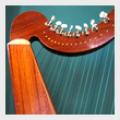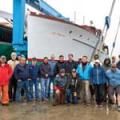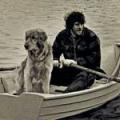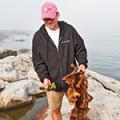“Man plans. God laughs.”
Building the Last Maine-Built Raceboat
Photos by Billy Black
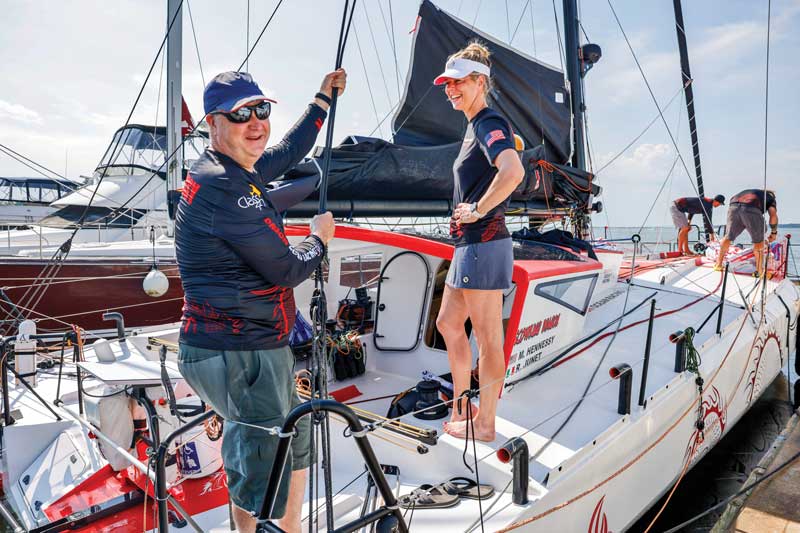 Michael Hennessy and Hannah Morrill prepare Scowling Dragon for the 2024 Atlantic Cup from Charleston, South Carolina, to Portland, Maine. On the bow, Kyle Hubley, left, and Roger Junet prepare headsails for the race.
Michael Hennessy and Hannah Morrill prepare Scowling Dragon for the 2024 Atlantic Cup from Charleston, South Carolina, to Portland, Maine. On the bow, Kyle Hubley, left, and Roger Junet prepare headsails for the race.
Four thousand five hundred and eighty. That was the magic number.
According to the box rule for the international Class 40 Association, that is the minimum allowable lightship displacement in kilograms for a 40-foot sailboat designed to race across oceans. Any weight beyond 4,580 kilograms (about 10,100 pounds) would abruptly strip away the boat’s competitive edge. This was the problem Brian Harris and his crew at Portland’s Maine Yacht Center wrestled with every day through the winter of 2023–24 as they built out Scowling Dragon, Class 40, Number 200.
“Maine Yacht Center was never intended to have anything to do with this project,” said Harris, MYC’s general manager and himself the second-place finisher of the inaugural Globe 40 round-the-world race in 2023 aboard Amhas, his Class 40, Number 127. (See “Chasing Liquid Mountains,” MBH&H, April/May 2023.)
When Michael Hennessy commissioned the United Kingdom-based Owen-Clarke design team to replace Dragon, his 2008 Class 40, Number 54, he was leaping through five design generations in a class that started two decades ago with mostly amateur racer-cruiser intentions. “You had to have a head, four bunks, a chart table,” said Hennessy of the first Class 40 generation. Since then, the cabin furniture has been stripped away, the hulls have filled out forward, and the rigs have been brought farther aft, all to keep the bow up, improve righting moment, and promote powerful reaching speeds in an offshore fleet where sailors without full professional sponsorship packages can still compete.
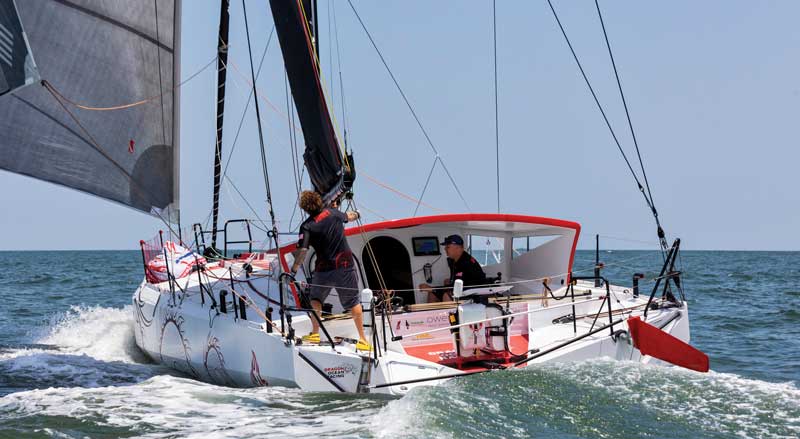 The Owen-Clarke-designed Scowling Dragon, built for swift offshore reaching speeds, reflects five generations of Class 40 development.
The Owen-Clarke-designed Scowling Dragon, built for swift offshore reaching speeds, reflects five generations of Class 40 development.
For well over a decade, Hennessy modified Number 54 and stayed reasonably competitive. “Over the years we put Dragon on a diet several times,” said Harris, “with new keel, new rudders, shaving weight out to make the boat faster.” The first Dragon raced to respectable finishes through the teens, including in the 2018 Route du Rhum, but eventually the design generations overtook Hennessy’s 2008 boat. (Some 500,000 YouTube followers got to know Number 54 as First Light when 29-year-old Cole Brauer sailed her around the world to finish second in the 2023–24 Global Solo Challenge.)
The present Class 40 sixth generation features a “scow bow,” a concept that’s been consistently winning transoceanic races since 2018. Hennessy’s plan was to build the new hull and deck at Evolution Marine in South Africa, then ship the parts to France for final assembly and fit-out. “The majority of top Class 40s are in France,” said Harris, “and that’s where the majority of the expertise is.” Hennessy aimed to shake the boat down in several European races over the 2023 summer, then cross back to North America as a competitor in the October Transat Jacques Vabre. But Cape Town endured a season of illness and power outages, and that included boatbuilders. The build schedule “just went pear-shaped,” said Harris. By June 2023, having missed the European season entirely, Hennessy made the call to pull the boat from South Africa and ship it to Maine.
What did the MYC crew find when they opened the shrink-wrapped package? “It wasn’t as built as we’d thought it would be,” said Harris. “There was no cabin house, no cockpit, no aft deck. It was an incomplete fiberglass box.”
Harris had studied yacht design at the Landing School in the 1980s and by the mid-aughts had made his name as the top American preparateur of IMOCA 60 offshore raceboats, with a portfolio that included high-profile projects for Josh Hall, Emma Richards, Alex Thompson, and Rich Wilson, in such events as the Vendée Globe and several record-setting passages. Two of MYC’s crew, Will Rooks and Steve Tillotson, had worked for Goetz Marine Technology in Rhode Island, a state-of-the-art builder of custom raceboats. But like so many other U.S. boatbuilders, Goetz had long since gone out of business. Meanwhile, the design and technology in these boats has only been accelerating. MYC brought in a couple of specialists from Europe, as well as Class 40 expert Kyle Hubley from Canada to oversee phases of the Scowling Dragon project.
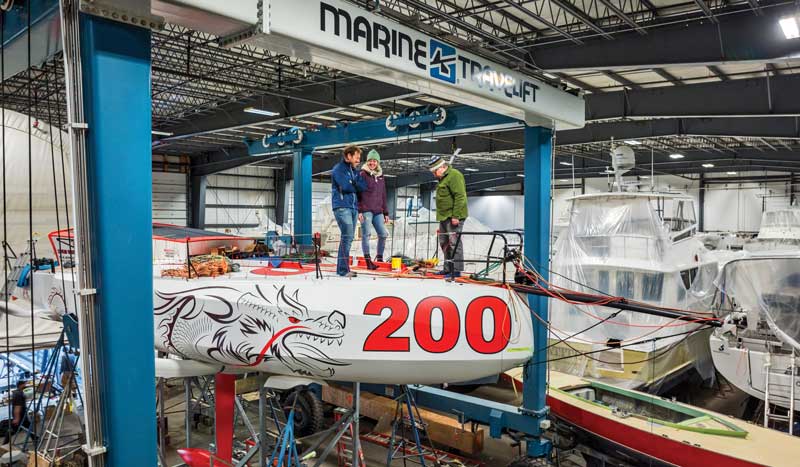 The crew at Maine Yacht Center in Portland drew on deep yacht-design and raceboat-building experience to complete the build of such a cutting-edge ocean-racing machine
The crew at Maine Yacht Center in Portland drew on deep yacht-design and raceboat-building experience to complete the build of such a cutting-edge ocean-racing machine
“These boats are very light,” said Harris. “Building at that weight level requires a lot of complex construction methods. You can’t just throw fiberglass at it.” Class 40 rules prohibit carbon fiber in the hull or deck structure. Not only that, but the contemporary scow bow means much more material in the fuller hull form. To reduce weight, designers prescribe highly engineered unidirectional E-glass, all precisely oriented during layup. “A lot of the construction drawings had very detailed scantlings and procedures about which all these laminations needed to happen. We had to brush up on our AutoCAD. The whole time, we were weighing fiberglass cutoffs, resin—even sanding dust. We had detailed spreadsheets tracking all these weights. You can skyrocket past 4.5 tons pretty quickly if you’re not careful.”
Working with epoxy resin required building a dedicated oven to post-cure the whole structure before painting. That meant bringing the boat up to 160 degrees Fahrenheit and holding it at that temperature for 48 hours, all during a Maine winter in a marginally insulated shed. “We rented giant three-phase 100-amp heaters, and we had fans throughout the boat,” said Harris. “To make sure the temperature was uniform, we put thermocouples every 4 meters running to a computer software program.”
Fitting the keel was its own special problem. “The keel fin was CNC-machined out of a high-tensile grade of steel from New Zealand, and the bulb was cast in England,” Harris said. “The designer’s system of fitting the keel head into the boat left zero tolerance between the keel head and the composite box that it sockets up into. Of course, they always fit like a glove in AutoCAD. But in the real world, they don’t always fit.”
In the heyday of custom boatbuilding, there were dedicated suppliers and job shops to support this kind of work. But those shops are becoming ever scarcer. “That’s why nobody in the U.S. builds custom offshore raceboats anymore,” said Harris.
But Maine Yacht Center did build this boat—and launched it just in time to start the 2024 doublehanded Atlantic Cup in Charleston, South Carolina, with plans to compete in such other high-profile events as the 2024 Quebec-St. Malo Race and the Normandy Channel Race, followed by the 2025 Fastnet Race and the doublehanded Transat Jacques Vabre from France to Brazil.
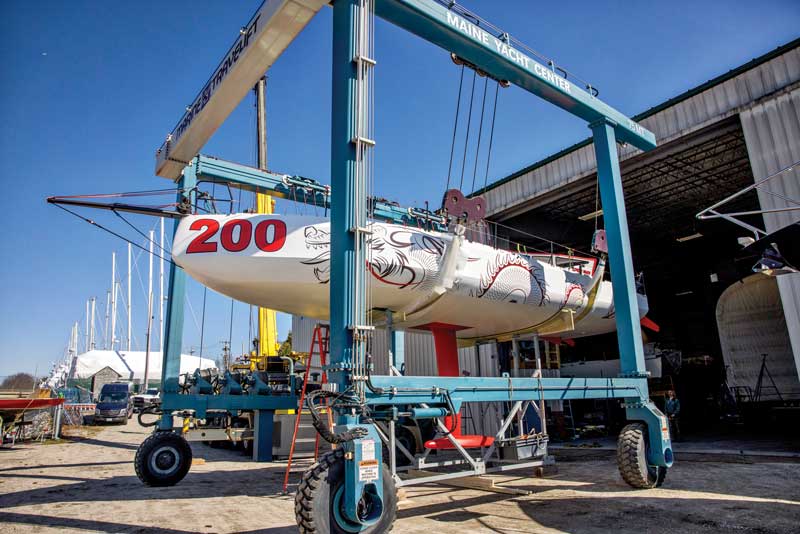 Scowling Dragon’s lines, with her flat underwater sections and the beam carried well forward, reflect the latest winning trends in offshore sailboat racing
Scowling Dragon’s lines, with her flat underwater sections and the beam carried well forward, reflect the latest winning trends in offshore sailboat racing
That was the plan. But as Michael Hennessy put it, “Man plans. God laughs.” The cosmic joke in this case occurred 200 miles off Cape May, New Jersey, on the first leg of the Atlantic Cup from Charleston, South Carolina, to Newport, Rhode Island. Hennessy had had just 24 hours of sailing time on the new boat when he found himself racing with crewmate Roger Junet, himself fresh off the 2022–23 Globe 40 round-the-world race with Joe Harris aboard the Class 40 Gryphon Solo II. In squally weather Scowling Dragon was reaching off the wind in 30 to 35 knots of breeze. “The boat was well balanced,” said Hennessy, “with two headsails, a staysail and a fractional headsail tacked to the end of the bowsprit.” The sprit was a carbon appendage supplied by a different South African contractor from the European one that supplied the mast and boom.
“It was midnight, because, you know, everything bad happens at midnight,” said Hennessy. The autopilot was steering the boat. Junet was sleeping below. Hennessy was on watch in the cockpit. Through the evening, they’d seen rain showers ahead, sometimes lightning behind, as a weather front moved through the area. Then, suddenly, in a 10-second span, the wind spiked from 33 knots to 53 knots. Hennessy was thrown across the wide cockpit onto a winch; below, Junet rolled into the net around his bunk. The boat, which normally sails at 22 degrees of heel, was pinned at 72 degrees.
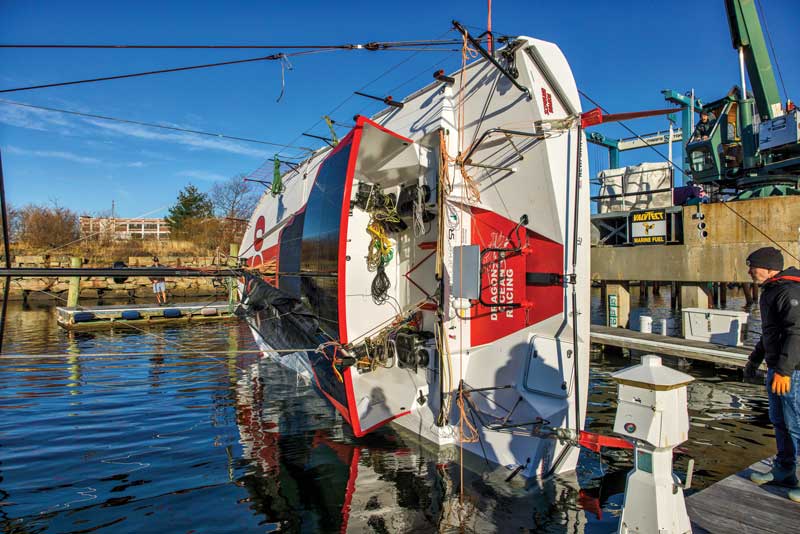 Scowling Dragon submits to an incline stability test, as required by Class 40 rules.
Scowling Dragon submits to an incline stability test, as required by Class 40 rules.
“Just doing the math,” said Hennessy, “that probably would have put the lower spreader in the water.”
Hennessy climbed back to the high-side winches, released the sheets, and eventually got the boat righted again. “Roger came up on deck, and we started trying to furl in the headsails, because they were flogging like mad.” But the sails wouldn’t furl.
It was at this point that the pair realized that the violent broach had broken the boat’s bowsprit. Unable to furl the forward headsail, they turned the boat downwind, using the mainsail to give some shelter. But no luck. So they tried first to drop the sail onto the deck.
“We couldn’t get it pulled back down toward the deck,” said Hennessy. “It was a big sausage-roll mess. So, we unpinned the sail from the furler, secured the furler, then had to cut the sheets off the sail in order to dump the whole sail over the side—which obviously was not pleasant to see go away.” They fished the stub of the bowsprit out of the water, cut it off the bobstay that held it to the boat’s bow, and got the stub below into the cabin.”
“That’s when we figured out the boat was sinking,” said Hennessy.
What had happened?
“The bobstay basically cheese-wired its way through the bow, trying to cut the bow off the boat,” said Hennessy. It ultimately got stopped by a bulkhead near the bow that prevented it from sawing the bow completely off. “So we closed the watertight bulkhead, pumped out the water, waited 30 minutes to make sure the bulkhead was going to hold, then figured out where we would go.”
Sure enough, God laughs. The duo went where they had planned to go—Newport, Rhode Island—just not in the way they’d planned. Sailing is like that sometimes. From Newport Scowling Dragon limped back to her familiar spot at Maine Yacht Center, where the team put her back in fighting trim.
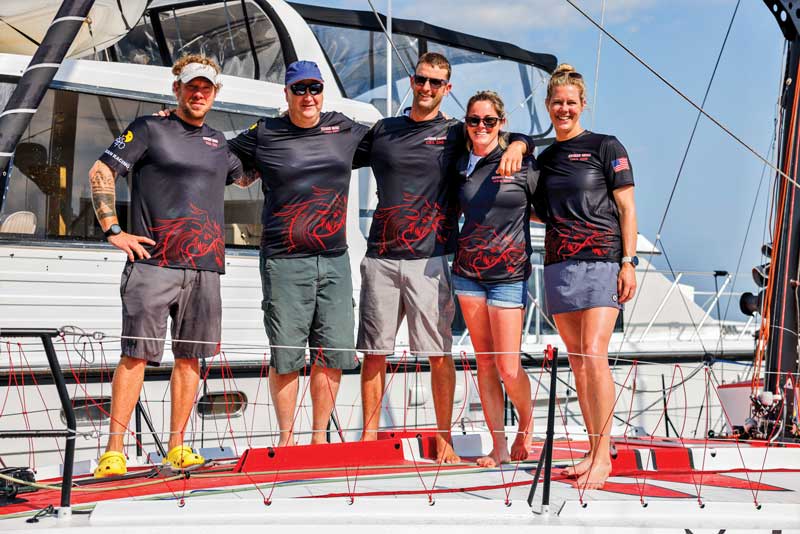 Competitors Roger Junet and Michael Hennessy, with shore crew Kyle Hubley, Alison Nelder, and Hanna Morrill, are on hand before the start of the 2024 Atlantic Cup.
Competitors Roger Junet and Michael Hennessy, with shore crew Kyle Hubley, Alison Nelder, and Hanna Morrill, are on hand before the start of the 2024 Atlantic Cup.
So, 2024 was a bust. But every new year is full of promise, and 2025 especially so. At the end of the season, Hennessy was at it again, making plans. “My intention is to relaunch early in the spring, do some work-up, then figure out what my work schedule will allow,” he said. Will it be closer to home, with events like the Bermuda One-Two, Block Island Race Week, and the Ida Lewis Distance Race—“get more experience in shorter races and break things when there’s easier consequences to deal with”?
Or will it be transatlantic with the New York Yacht Club, followed by the Fastnet, and the doublehanded Transat Jacques Vabre?
“I really do hope I’ve broken most of what I’m going to break,” he said.
✮
Tim Murphy is the education director at the American Boat & Yacht Council and the author of Adventurous Use of the Sea (Seapoint Books, 2022).
Related Articles
Share this article:
2023 Maine Boat & Home Show

Join Us for the Maine Boat & Home Show!
Art, Artisans, Food, Fun & Boats, Boats, Boats
August 11 - 13, 2023 | On the waterfront, Rockland, Maine
Click here to pre-order your tickets.
Show is produced by Maine Boats, Homes & Harbors magazine.









